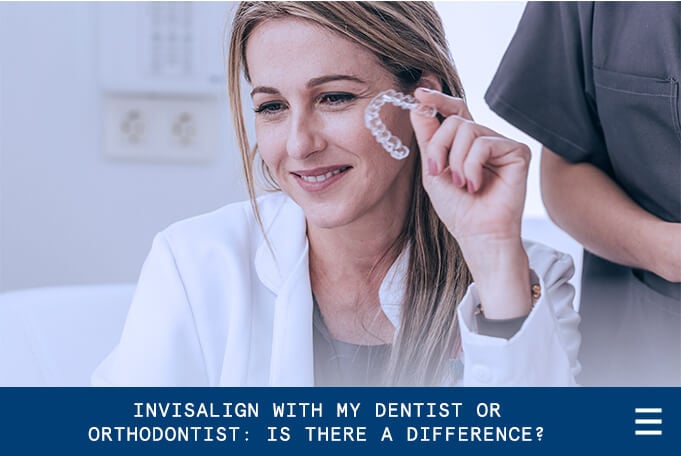In deciding which is better, braces or Invisalign Clear Aligners, we need to first clarify what we mean by better. If we’re talking about the patient experience, Invisalign was initially developed for that purpose. It is more aesthetically pleasing, doesn’t hurt as much (if at all), and it’s more hygienic. Patients who previously had braces, rave about their experience with Invisalign.
Patient Experience
Invisalign Clear Aligners are nearly invisible and have a digital fit to the teeth. Furthermore, they can be removed for hours in social situations. The tooth-colored attachments – necessary to effectively move teeth – may show but they’re inconspicuous compared to braces. The brackets and wires that comprise braces can irritate the cheeks and may come loose if you bite on something hard. Braces come with a list of banned foods but since aligners are taken out for eating, there are no restrictions. Broken brackets and poking wires are not only uncomfortable, they often require making an emergency repair which may be inconvenient and result in an extra charge. Aligners never have emergencies and we have even replaced most office visits with a highly precise mobile treatment management app.
Effectiveness
All considered, not many people would question that patients have a better experience with Invisalign Clear Aligners than with traditional braces. But how about effectiveness? When Invisalign was first introduced more than 20 years ago, it was promoted for mostly minor cases because the product was in its infancy and most orthodontists didn’t have much experience with it. We liked it for minor cases and over the years, like many doctors, we kept expanding the types of problems that we would treat. Concurrently, Align Technology kept improving their product with more than $1 billion invested in research and development and providing platforms for doctors to share their cases and their protocols. A new more flexible plastic was introduced, customized attachments were developed and principles of biomechanics were applied beyond what had been routine with braces. With our experience and these innovative advancements, Invisalign became more effective and more efficient than braces in most cases.
Digital Accuracy
When compared to traditional braces, the core difference with Invisalign Clear Aligners is that treatment is developed using a 3D computer model. Braces are a series of estimated adjustments and re-evaluations where treatment is accomplished in stages. Our advanced digital modeling enables us to accurately render the patient's new smile before they even begin treatment. A draft of the treatment is provided by technicians, based on the doctor’s prescription and preferences. If needed, the doctor can then make as many modifications as necessary to provide the patient with the exact smile they wish to achieve. While experienced practitioners can achieve great results with traditional metal braces, aligners allow doctors to target a predetermined goal where every tiny amount of movement is 100% useful, requiring no estimated movements and the movements are happening all at the same time versus in stages.
Biology and Physics of Tooth Movement
To understand the difference between braces and Invisalign Clear Aligners, it is helpful to understand how orthodontics works and how we’re able to move teeth. We are not physically pushing the roots of teeth through bone, we’re just stimulating the bone to remodel and allow teeth to move in a very precise direction. Research increasingly shows that the lighter the force, the faster the teeth move. When you look at a set of metal braces with wires, it looks more powerful than the thin aligner plastic. Remarkably, plastic is much more powerful. It delivers lighter, more biological forces that are highly measured. With braces nothing is measured. Some teeth get too much force and other teeth may not get anything. Also, wires deliver heavier forces when first tied in, resulting in considerable discomfort the next few days. With aligners, the forces are more measured and more consistent since aligners are changed every week or two, as compared to wires that are changed every few months.
Another pro to aligners is the capability to eliminate unnecessary office visits with remote monitoring. Since the whole treatment process has been pre-planned on a computer model, office visits are mostly to check that the aligners are fitting well. With a mobile app we can determine each week whether the patient is ready to move on to the next aligner. This allows for part-time wear and variable wear. If the patient is ready, they can move forward faster, but if they are starting to go off track, we can slow down the treatment and get them back on track, saving many months of treatment time. While all cases are different and patients can choose their level of commitment, most Invisalign cases can be finished in less than a year, while braces cases used to run an average of two years or more.
Cost
While the Invisalign system costs us – the doctors – more than a set of braces, the savings in terms of fewer office visits, faster treatment and happier patients has allowed us to actually charge the same for Invisalign Clear Aligners. That has been our policy for more than ten years.
The Take Away
Invisalign Clear Aligners are more comfortable, more aesthetically pleasing and up to 50% faster than braces. Although it was originally developed to be an alternative for those that did not want to deal with braces, remarkable product developments through treatment simulation software and 3D printing has led to a teeth straightening system that, in the oversight of an experienced doctor, outperform braces in most cases.






